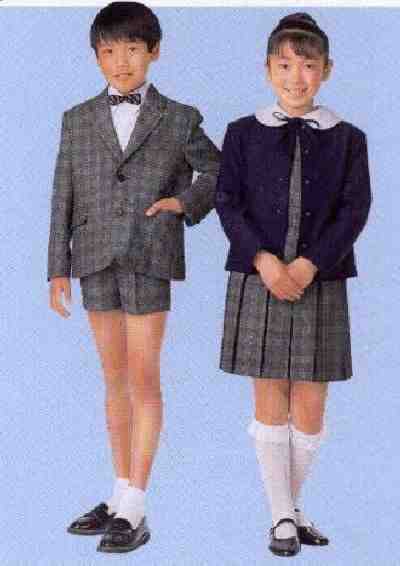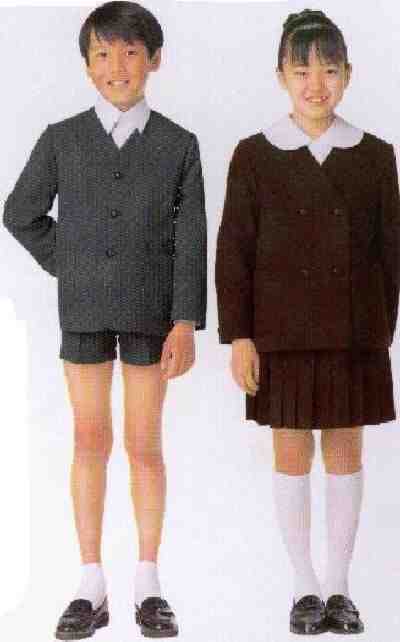
Figure 1.--Patterned suits are usually only worn at public schools, private schools often select more conservative solid colored suits or blazers. The same pattern may be used for the girls' suits or dresses.

Boys at some Japanese schools wear suits at least for special occasions. Solid colored blue and grey suits are common, but patterned suits are also worn at some schools. Solid colors are generally worn at private schools, but some public schools have patterened suits. Boys at many schools wear the American Eron suit which has a jacket without lapels. Sometimes the girls wear dresses or skirts in the same patterns. Almost always suits are only worn at elementary schools, although quite a number of secondary schools have begun replazing the old military-styled uniform with English-style blazers.
HBC's Japanese consultant notes that these patterned suits are not normally wore for everyday schoolwear, but instead only for ceremonial functions, like the first day of school. Thus it is usually not a uniform as such. The school may not require a special pattern. Thus while most of the boys may dress up for special occasions, theybmay not all wear the same style of suit.
Boys wear a variety of suit styles, usually for dress occasions. A few private schools havde suits as uniforms, but this is rare in public schools. The single breasted suit is the most common suit worn for dress occasions. The suit can be both solid colors or a variety of patterns. The patterned suits are usually worn by younger boys at a public school for special occasions such as the school entrance ceremony. The school usually makes no effort to chose a common pattern. A few private schools require suits be worn for everyday schoolwear. A few boys wear double breasted suits for special occasions, but they are much less common than single breasted suits. One common style for a younger boy's suit is the American Eton suit--the suit for small boys with a usually short cut jacket lacking lapels. The American Eton suit first appeared in America during the 1920s. I have not noticed this style in Japan until the 1950s. It is a common choice for a boys' suit to be worn at school occasions. These suits are almost always solid blue or grey. A patterned Eton suit is not common. Although not a suit per se, a related style is the blazer. While mostly younger boys wear suits, mostly for special occasions, many secondary schools have adopted blazers as a school uniform.
We notice that most state schools have simple uniforms, often white shirts and blue shorts. Some schools had blazers--frequently blue blazers. We do not see many state schools which have suits for uniforms. Japan is, however, a large country and there may well be some. The suits from school uniform catalogs on this page presumably were for state schools so such schools must exist. Private schools tend to have more elaborate uniforms, in some cases formal suits. There are relatively few private schools in Japan compared to the state schools. The private schools we have noted mostly have more elaborate uniforms whuch are often structly enforced. We have noted both blue and grey suits. Several private schools we have noted have uniforms with blue suits. Only a few have grey suits.

Figure 2.--A popular choice for a boy's school suit is the American Eton suitvwith its characteristc short jacket withoutvlapels.. |
Getting in to the right school is very important to Japanese children and their parents. If the children get into the appropriate elementary feeder school they can avoid the exam hell that so affects the childhood of many Japanese children. It can also ensure entrance into prestigious universities, assuring job offers from Japan's largest corporations. Thus it is critical that the children and parents make a good impression at school interviews. Department schools offer guidance on how the children and their parents should dress. There are even fairs with different stores offering fashion advice. One of the most critical factors on whic most stores agree is that the boys should wear conservative suits or blazers with short pants. These suits are then worn for special occasions at school--primarily the entrance ceremony.
We do not have a lot of information about how suits are worn at Japanese schools. These are not school uniforms in the sense that thgey have the school badge on the jacket, but rther what look like srandard suits that could be worn for any dress up occassion. We do note a few advertisements of jackets with creasts, but this may be a kind of representative badge rather than a real school badge. We do know that they seem more common at private schools than state schools. Also we seem to notice that almost all available images show quite young boys wearing these suits. This seems to us to suggest that they are primzrily intended for school interviews and first day ceremonies. They may be worn at other special events at school. We do not, however, see many images of older boys wearing them, except at private scools with have suits for the standard school uniform.
The suits on this page are commonly worn for special school occasions. Although Japanese boys do not often dress up in suits for non-school occasions, they do occasionally. There are suits available for these occasions in a greater range and colors than suits more closely associated with school.
'
We do not notice these suits being worn with caps. At least there were no matching caps in the available catalog advertisements. We note the suits being worn with both ankle and kneesocks. We alkso notice both white and colored socks. Normally the convention is to match the color of the sovks and suit or wear white socks. Almost always the suits are shown as being worn with dark leather shoes. For schoolwear, however, senekers are very common in Japan, but the suits are normally wornb with keather shoes.
Most Japanese catalogs s would be expected show Japanese children modeling the school uniform garments. We have, noted, however, quite a few catalogs that use Western children. I'm not precisely sure why this is. I think perhaps the idea is that Western children give the clothes a stylish image. I am not entirely sure just why this is. Western children seem especially prevalent in the catalog pages devoted to suits.
Related Chronolgy Pages in the Boys' Historical Web Site
[Main Chronology Page]
[The 1900s]
[The 1910s]
[The 1920s]
[The 1930s]
[The 1940s]
[The 1950s]
[The 1960s]
[The 1970s]
[The 1980s]
[The 1990s]
[The 2000s]
